 The Two Micron All Sky Survey at IPAC
The Two Micron All Sky Survey at IPAC
![]()
 The Two Micron All Sky Survey at IPAC
The Two Micron All Sky Survey at IPAC
|
|
|
The galaxy group Stephan's Quintet (NGC 7317). This group is also
known as Hickson compact groups 31 and 92. These galaxies are tidally
interacting, stripping gas and stars from each other.
(Field size 8.3´ × 7.0´. Image size 254 kB.)
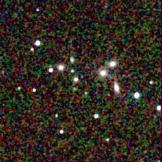 HCG 20, a Hickson (1982, ApJ, 255, 382) compact group (HCG) of
galaxies. Such groups are among the densest extragalactic environments.
These systems therefore serve as ideal
laboratories for studies of galactic interaction, merging, and cannibalism.
(Stephan's Quintet, or HCG 92, above, is another well-known
example.) The majority of HCGs do not appear to have formed from rich
galaxy systems; the formation process must act in regions of relatively low
galaxy density, possibly through the presence of large potential wells of
dark matter (Palumbo et al. 1995, AJ, 109, 1476). This is borne out by recent
X-ray studies of HCGs, which reveal large extended dark matter halos around
groups (e.g., Ponman et al. 1996, MNRAS, 283, 690). (Field size 4.5´ × 4.3´. Image size 119 kB.)
HCG 20, a Hickson (1982, ApJ, 255, 382) compact group (HCG) of
galaxies. Such groups are among the densest extragalactic environments.
These systems therefore serve as ideal
laboratories for studies of galactic interaction, merging, and cannibalism.
(Stephan's Quintet, or HCG 92, above, is another well-known
example.) The majority of HCGs do not appear to have formed from rich
galaxy systems; the formation process must act in regions of relatively low
galaxy density, possibly through the presence of large potential wells of
dark matter (Palumbo et al. 1995, AJ, 109, 1476). This is borne out by recent
X-ray studies of HCGs, which reveal large extended dark matter halos around
groups (e.g., Ponman et al. 1996, MNRAS, 283, 690). (Field size 4.5´ × 4.3´. Image size 119 kB.)
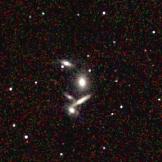 Atlas Image mosaic of the Hickson Compact Group
40 (HCG 40, aka Arp 321 and VV 116; Hickson 1982, ApJ, 255, 382).
This isolated ensemble of seven galaxies (five of which are clearly seen in
the 2MASS Image), at a redshift z=0.022,
like the other HCGs, provides an interesting laboratory for
studying the effects of close proximity and possible interaction on the
evolution of galaxies. For instance, how these factors influence the
presence of active galactic nuclei (e.g., Coziol et al. 1998, ApJ, 493, 563).
HCG 40 is dominated by a giant elliptical galaxy (seen toward the center of
the image). The giant elliptical and the two smaller spiral galaxies all
show some levels of nuclear activity. The HCGs also offer the possibility
to measure the amount of dark matter in the groups through their relative
motion and the inferred mass-to-light ratios (M/L) for the groups. A
kinematical study of the group
suggest that it is a dynamical and compact septet of galaxies, covering
only 749 kpc (Ribiero et al. 1998, ApJ, 497, 72). HCG 40's self-gravitating
M/L~33, along with the ratios of other HCGs, imply
a cosmological density parameter
Atlas Image mosaic of the Hickson Compact Group
40 (HCG 40, aka Arp 321 and VV 116; Hickson 1982, ApJ, 255, 382).
This isolated ensemble of seven galaxies (five of which are clearly seen in
the 2MASS Image), at a redshift z=0.022,
like the other HCGs, provides an interesting laboratory for
studying the effects of close proximity and possible interaction on the
evolution of galaxies. For instance, how these factors influence the
presence of active galactic nuclei (e.g., Coziol et al. 1998, ApJ, 493, 563).
HCG 40 is dominated by a giant elliptical galaxy (seen toward the center of
the image). The giant elliptical and the two smaller spiral galaxies all
show some levels of nuclear activity. The HCGs also offer the possibility
to measure the amount of dark matter in the groups through their relative
motion and the inferred mass-to-light ratios (M/L) for the groups. A
kinematical study of the group
suggest that it is a dynamical and compact septet of galaxies, covering
only 749 kpc (Ribiero et al. 1998, ApJ, 497, 72). HCG 40's self-gravitating
M/L~33, along with the ratios of other HCGs, imply
a cosmological density parameter  0~0.2-0.4
(Ribiero et al.). The compactness of HCG 40 implies that it will evolve
through strong galaxy merging on a timescale of a few group crossing times.
Most of the HCGs have been observed by 2MASS so far; many of these, included
HCG 40, are included in the Second Incremental Data Release. HCG 40
was previously imaged in the near-IR by Bushouse & Stanford (1992, ApJS, 79,
213). The near-IR light of galaxies is dominated by the major mass
components and, therefore, can best be used to study the relationship between
galaxy interaction, activity, and morphology. Image mosaic by S. Van Dyk
(IPAC). (Field size 6.0´ × 6.0´. Image size 170 kb.)
0~0.2-0.4
(Ribiero et al.). The compactness of HCG 40 implies that it will evolve
through strong galaxy merging on a timescale of a few group crossing times.
Most of the HCGs have been observed by 2MASS so far; many of these, included
HCG 40, are included in the Second Incremental Data Release. HCG 40
was previously imaged in the near-IR by Bushouse & Stanford (1992, ApJS, 79,
213). The near-IR light of galaxies is dominated by the major mass
components and, therefore, can best be used to study the relationship between
galaxy interaction, activity, and morphology. Image mosaic by S. Van Dyk
(IPAC). (Field size 6.0´ × 6.0´. Image size 170 kb.)
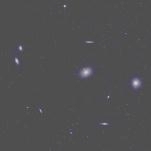 Atlas Image Mosaic of the heart of the
Virgo Cluster of galaxies. This famous galaxy cluster, seen toward the
constellation Virgo and covering in total
more than 7° on the sky, is the closest large cluster to us, at a
distance of about 17 Mpc (55 million light years). Together
with other nearby groups and clusters, the Local Group of galaxies, of which
the Milky Way is a member, form a much larger organizational unit,
the Local Supercluster of
galaxies. The cluster was first discovered by Charles Messier in the late
18th century; hence, many of its component galaxies are
Messier objects. To the center right of this
near-infrared mosaic are the two giant elliptical galaxies, Messier 86, or M86,
and M84. Other smaller spiral
galaxies are also seen in this image. Not included in this image of the
cluster heart is the giant elliptical, M87,
to the southeast, with its famous gaseous jet, emanating from a central
supermassive black hole in the galaxy. Image mosaic by T. Jarrett (IPAC).
(Field size 50.0´ × 50.0´. Image size 6.0 Mb!.)
Atlas Image Mosaic of the heart of the
Virgo Cluster of galaxies. This famous galaxy cluster, seen toward the
constellation Virgo and covering in total
more than 7° on the sky, is the closest large cluster to us, at a
distance of about 17 Mpc (55 million light years). Together
with other nearby groups and clusters, the Local Group of galaxies, of which
the Milky Way is a member, form a much larger organizational unit,
the Local Supercluster of
galaxies. The cluster was first discovered by Charles Messier in the late
18th century; hence, many of its component galaxies are
Messier objects. To the center right of this
near-infrared mosaic are the two giant elliptical galaxies, Messier 86, or M86,
and M84. Other smaller spiral
galaxies are also seen in this image. Not included in this image of the
cluster heart is the giant elliptical, M87,
to the southeast, with its famous gaseous jet, emanating from a central
supermassive black hole in the galaxy. Image mosaic by T. Jarrett (IPAC).
(Field size 50.0´ × 50.0´. Image size 6.0 Mb!.)
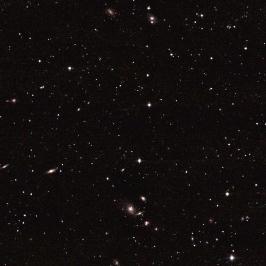 Abell 262.
(Field size 8.1´ × 8.1´. Image size 376 kb.)
Abell 262.
(Field size 8.1´ × 8.1´. Image size 376 kb.)
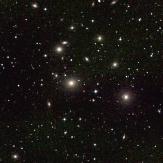 Atlas Image mosaic of Abell 426, better known as the Perseus Cluster,
a nearby rich galaxy cluster. The cluster is notable with its prominent
grouping of bright galaxies near the core and an exceptionally
strong deficiency of spiral galaxies. The cluster is dominated by NGC 1275,
the strong radio source Perseus A, ther bright galaxy seen near the center
of the 2MASS image mosaic; the bizarre galaxy has an active nucleus, with
bright, extended radio lobes, and evidence that the galaxy is the remnant of
a recent merger. The x-ray emission from the cluster,
and the fact that the cluster hosts several galaxies with active nuclei,
pronounced radio structures, enhanced far-infrared emission, and signs of
strong gravitational interactions, have been interpreted as signs of a
merger of galaxy clusters. Studies of the Perseus cluster are hampered by its
low galactic latitude (l=150.6°, b=-13.3°), resulting
in a high density of Galactic foreground stars and appreciable extinction in
the optical. In the 2MASS near-infrared image the extinction has been
substantially reduced, and the galaxy light appears much smoother than it
does in the optical.
(Field size 15.0´ × 29.9´. Image size 1.5 Mb!.)
Atlas Image mosaic of Abell 426, better known as the Perseus Cluster,
a nearby rich galaxy cluster. The cluster is notable with its prominent
grouping of bright galaxies near the core and an exceptionally
strong deficiency of spiral galaxies. The cluster is dominated by NGC 1275,
the strong radio source Perseus A, ther bright galaxy seen near the center
of the 2MASS image mosaic; the bizarre galaxy has an active nucleus, with
bright, extended radio lobes, and evidence that the galaxy is the remnant of
a recent merger. The x-ray emission from the cluster,
and the fact that the cluster hosts several galaxies with active nuclei,
pronounced radio structures, enhanced far-infrared emission, and signs of
strong gravitational interactions, have been interpreted as signs of a
merger of galaxy clusters. Studies of the Perseus cluster are hampered by its
low galactic latitude (l=150.6°, b=-13.3°), resulting
in a high density of Galactic foreground stars and appreciable extinction in
the optical. In the 2MASS near-infrared image the extinction has been
substantially reduced, and the galaxy light appears much smoother than it
does in the optical.
(Field size 15.0´ × 29.9´. Image size 1.5 Mb!.)
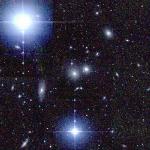 Atlas Image mosaic of the Hydra Cluster of galaxies,
aka Abell (ACO) 1060. More than a hundred galaxies are seen clustered toward
the southern constellation Hydra. The "haloes" around the infrared bright
Milky Way foreground stars (HD 92036, a M-type giant to the northeast, and HD
91964, a K-type giant to the southwest; the halo of the brighter star is
truncated, due to the 2MASS scan edge) dominate the image. But, compare this
2MASS image with an
optical image: In the near-infrared, the optical veneer of recently-formed
hot, bright blue stars, the gaseous nebulae, and dark lanes of dust in the
cluster's galaxies is stripped away to reveal the bulk of the galaxies' mass,
namely, the cool, lower-mass stars. Because these stars have existed
for a much longer time and have had time to move away from their birthplaces
within the galaxies, the distribution of their infrared light is quite smooth.
The morphology for galaxies of different Hubble
type (spirals and ellipticals)
therefore is more similar in the near-infrared than in the optical.
(N.B.: The full mosaic is 13.6 Mb in size!
A smaller, 4´´× 4´´-binned, 852-kb version of the
mosaic can be obtained here.)
(Field size 1° × 1°. Image size 13.6 Mb!)
Atlas Image mosaic of the Hydra Cluster of galaxies,
aka Abell (ACO) 1060. More than a hundred galaxies are seen clustered toward
the southern constellation Hydra. The "haloes" around the infrared bright
Milky Way foreground stars (HD 92036, a M-type giant to the northeast, and HD
91964, a K-type giant to the southwest; the halo of the brighter star is
truncated, due to the 2MASS scan edge) dominate the image. But, compare this
2MASS image with an
optical image: In the near-infrared, the optical veneer of recently-formed
hot, bright blue stars, the gaseous nebulae, and dark lanes of dust in the
cluster's galaxies is stripped away to reveal the bulk of the galaxies' mass,
namely, the cool, lower-mass stars. Because these stars have existed
for a much longer time and have had time to move away from their birthplaces
within the galaxies, the distribution of their infrared light is quite smooth.
The morphology for galaxies of different Hubble
type (spirals and ellipticals)
therefore is more similar in the near-infrared than in the optical.
(N.B.: The full mosaic is 13.6 Mb in size!
A smaller, 4´´× 4´´-binned, 852-kb version of the
mosaic can be obtained here.)
(Field size 1° × 1°. Image size 13.6 Mb!)
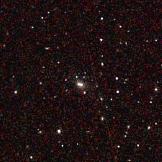
The very rich galaxy cluster Abell 1317, as observed from the southern
facility. The redshift of this cluster is 0.072. Most of the galaxies are
faint, but the brightest cluster galaxies, the pair of cD galaxies at
the center, are quite prominent. We will be able to discriminate stars from
galaxies on 2MASS images to redshift 0.2.
(Field size 8.3´ × 14.8´. Image size 478 kB.)
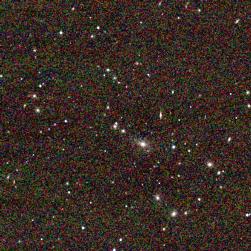 Abell 1589.
(Field size 15.3´ × 15.3´. Image size 1.9 Mb!)
Abell 1589.
(Field size 15.3´ × 15.3´. Image size 1.9 Mb!)
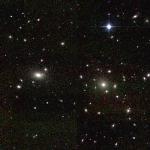 Atlas Image mosaic of the Coma cluster, aka
Abell 1656. This is a particularly rich cluster of individual galaxies (over
1000 members), most prominently the two giant ellipticals, NGC 4874
(right) and NGC 4889 (left). The remaining members are mostly
smaller ellipticals, but spiral galaxies are also evident in the 2MASS image.
The cluster is seen toward the constellation Coma Berenices, but is actually
at a distance of about 100 Mpc (330 million light years, or a redshift of
0.023) from us. At this distance, the cluster is in what is known as the
"Hubble flow," or the overall expansion of the Universe. As such, astronomers
can measure the Hubble Constant, or the universal expansion rate, based on the
distance to this cluster. Large, rich clusters,
such as Coma, allow astronomers to measure the "missing mass," i.e., the
matter in the cluster that we cannot see, since it gravitationally influences
the motions of the member galaxies within the cluster. The near-infrared maps
the overall luminous mass content of the member galaxies, since the light at
these wavelengths is dominated by the more numerous older stellar populations.
Galaxies, as seen by 2MASS, look fairly smooth and homogeneous, as
can be seen from the Hubble "tuning fork"
diagram of near-infrared galaxy morphology. Image mosaic by S. Van Dyk
(Field size 34´ × 34´. Image size 3.7 Mb!.)
Atlas Image mosaic of the Coma cluster, aka
Abell 1656. This is a particularly rich cluster of individual galaxies (over
1000 members), most prominently the two giant ellipticals, NGC 4874
(right) and NGC 4889 (left). The remaining members are mostly
smaller ellipticals, but spiral galaxies are also evident in the 2MASS image.
The cluster is seen toward the constellation Coma Berenices, but is actually
at a distance of about 100 Mpc (330 million light years, or a redshift of
0.023) from us. At this distance, the cluster is in what is known as the
"Hubble flow," or the overall expansion of the Universe. As such, astronomers
can measure the Hubble Constant, or the universal expansion rate, based on the
distance to this cluster. Large, rich clusters,
such as Coma, allow astronomers to measure the "missing mass," i.e., the
matter in the cluster that we cannot see, since it gravitationally influences
the motions of the member galaxies within the cluster. The near-infrared maps
the overall luminous mass content of the member galaxies, since the light at
these wavelengths is dominated by the more numerous older stellar populations.
Galaxies, as seen by 2MASS, look fairly smooth and homogeneous, as
can be seen from the Hubble "tuning fork"
diagram of near-infrared galaxy morphology. Image mosaic by S. Van Dyk
(Field size 34´ × 34´. Image size 3.7 Mb!.)
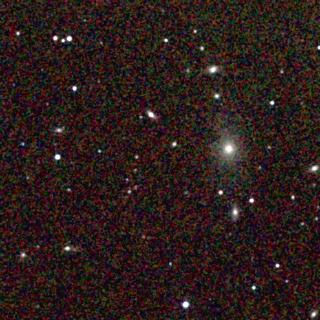 Abell 2589.
(Field size 8.1´ × 15.8´. Image size 572 kb.)
Abell 2589.
(Field size 8.1´ × 15.8´. Image size 572 kb.)
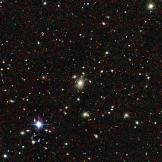 Atlas Image mosaic of the galaxy cluster Abell 3558,
also known as Shapley 8. This is a rich cluster, which has been the subject
of study at a number of wavelengths. The cluster is dominated by a central
giant cD galaxy (the brightest galaxy near the center of the 2MASS image),
which, interestingly enough, also lies near the center of the larger
Shapley concentration, or supercluster, of 25 clusters of galaxies, including
Abell 3558. Dantas et al. (1997, ApJ, 485, 447) recently found that the
cluster is actually composed of a collection of several groups
of galaxies, suggesting that it is a dynamically complex, young cluster of
galaxies. One of the data products released by 2MASS is an Extended Source
Catalog, much of which consists of galaxies. The 2MASS Processing Pipeline
measures magnitudes, sizes, and positions for extended sources through a large
number of possible apertures. To see a representative color-color diagram for
a 1°-radius area
centered on Abell 3558, click here;
shown on the diagram are the Bessell & Brett (1988, PASP, 100, 1134) and
Koorneef (1983, A&A, 128, 84) tracks for dwarf and giant stars, as well as
K-correction tracks for elliptical and spiral galaxies (in steps of
redshift z=0.1) and the reddening vector from Rieke & Lebofsky (1985,
ApJ, 288, 618). Abell 3558 is at z=0.048.
A radius vs. magnitude diagram for the cluster can also be
found here. Finally, a source count diagram
can be found here (the magenta crosses,
shown for reference, are deep, narrow-field generalized galaxy counts from
Gardner et al. (1997, ApJ, 480, L99).
For a larger 0.58° × 1.33° view of Abell 3558, click
here; this image is 9.7 Mb in size!
(A meteor streak can be seen through both the large and smaller view.)
Image mosaic by E. Kopan (IPAC). These data are included in the
Second Incremental Release!
(Field size 0.5° × 0.5°. Image size 3.0 Mb!.)
Atlas Image mosaic of the galaxy cluster Abell 3558,
also known as Shapley 8. This is a rich cluster, which has been the subject
of study at a number of wavelengths. The cluster is dominated by a central
giant cD galaxy (the brightest galaxy near the center of the 2MASS image),
which, interestingly enough, also lies near the center of the larger
Shapley concentration, or supercluster, of 25 clusters of galaxies, including
Abell 3558. Dantas et al. (1997, ApJ, 485, 447) recently found that the
cluster is actually composed of a collection of several groups
of galaxies, suggesting that it is a dynamically complex, young cluster of
galaxies. One of the data products released by 2MASS is an Extended Source
Catalog, much of which consists of galaxies. The 2MASS Processing Pipeline
measures magnitudes, sizes, and positions for extended sources through a large
number of possible apertures. To see a representative color-color diagram for
a 1°-radius area
centered on Abell 3558, click here;
shown on the diagram are the Bessell & Brett (1988, PASP, 100, 1134) and
Koorneef (1983, A&A, 128, 84) tracks for dwarf and giant stars, as well as
K-correction tracks for elliptical and spiral galaxies (in steps of
redshift z=0.1) and the reddening vector from Rieke & Lebofsky (1985,
ApJ, 288, 618). Abell 3558 is at z=0.048.
A radius vs. magnitude diagram for the cluster can also be
found here. Finally, a source count diagram
can be found here (the magenta crosses,
shown for reference, are deep, narrow-field generalized galaxy counts from
Gardner et al. (1997, ApJ, 480, L99).
For a larger 0.58° × 1.33° view of Abell 3558, click
here; this image is 9.7 Mb in size!
(A meteor streak can be seen through both the large and smaller view.)
Image mosaic by E. Kopan (IPAC). These data are included in the
Second Incremental Release!
(Field size 0.5° × 0.5°. Image size 3.0 Mb!.)
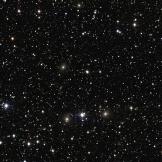 The relatively nearby (redshift z=0.016), very rich galaxy
cluster Abell 3627. The cluster, which lies at the core of the
Great Attractor, is at galactic longitude l=325°, but, more
importantly, is at the low galactic latitude b=-7.2°, i.e.,
near the Galactic Plane, where extinction from Galactic dust is significant.
The cluster has an internal velocity dispersion which implies a gravitational
mass comparable to that of the Coma cluster, another rich nearby cluster.
But, most intriguingly, Abell 3627's distance and direction puts it near the
predicted location of the center of the Great Attractor, implying that the
cluster may sit at the bottom of the Attractor's gravitational potential well.
The Great Attractor, so dubbed, is a position in the sky toward which a bulk
flow of galaxies appears to be moving (Lynden-Bell et al. 1988, ApJ, 326, 19).
In effect, the Attractor represents the center of a large mass concentration
of galaxies and galaxy clusters, of which our own Local Group is included,
known as the Local Supercluster. 2MASS is less susceptible
to the extinction toward Abell 3627 and the Great Attractor than observations
at optical wavelengths, and therefore will provide valuable clues as to its
true nature. Image mosaic by S. Van Dyk (IPAC).
(Field size 21.7´ × 41.7´. Image size 2.5 Mb!.
For a smaller version [449 kb], click here.)
The relatively nearby (redshift z=0.016), very rich galaxy
cluster Abell 3627. The cluster, which lies at the core of the
Great Attractor, is at galactic longitude l=325°, but, more
importantly, is at the low galactic latitude b=-7.2°, i.e.,
near the Galactic Plane, where extinction from Galactic dust is significant.
The cluster has an internal velocity dispersion which implies a gravitational
mass comparable to that of the Coma cluster, another rich nearby cluster.
But, most intriguingly, Abell 3627's distance and direction puts it near the
predicted location of the center of the Great Attractor, implying that the
cluster may sit at the bottom of the Attractor's gravitational potential well.
The Great Attractor, so dubbed, is a position in the sky toward which a bulk
flow of galaxies appears to be moving (Lynden-Bell et al. 1988, ApJ, 326, 19).
In effect, the Attractor represents the center of a large mass concentration
of galaxies and galaxy clusters, of which our own Local Group is included,
known as the Local Supercluster. 2MASS is less susceptible
to the extinction toward Abell 3627 and the Great Attractor than observations
at optical wavelengths, and therefore will provide valuable clues as to its
true nature. Image mosaic by S. Van Dyk (IPAC).
(Field size 21.7´ × 41.7´. Image size 2.5 Mb!.
For a smaller version [449 kb], click here.)
Return to 2MASS Image Gallery Homepage